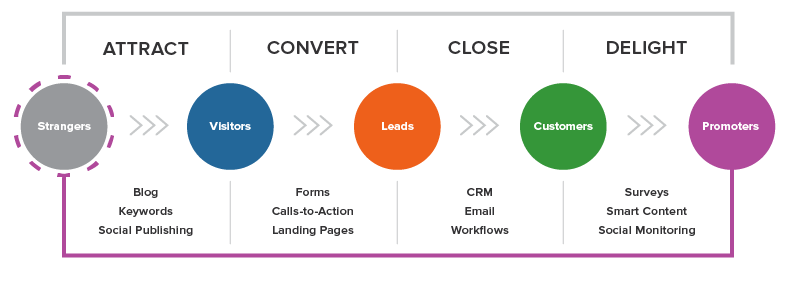How Can Inbound Marketing Help You Generate Traffic, Acquire Leads, and Convert Leads to Customers?
According to HubSpot’s State of Inbound 2016 Report, 74 percent of marketers say they prioritize converting contacts / leads into customers while 65 percent of marketers say their primary challenge is generating website traffic and leads.
to HubSpot’s State of Inbound 2016 Report, 74 percent of marketers say they prioritize converting contacts / leads into customers while 65 percent of marketers say their primary challenge is generating website traffic and leads.
This is confusing.
Why are marketers prioritizing converting contacts into customers if they can’t generate traffic and leads from their website? This is the common problem of a company creating a beautiful website and expecting it to do all the work. Many companies do not realize that a well-designed website is not enough – you need content and well thought out conversion opportunities in order to generate meaningful leads. Not following me? Here’s a real-word example of how you need content to close a deal.
Not Enough Content = No Second Date
Pretend you are single and looking for love. You have not had much success meeting people in your area so you sign up for an online dating service. You create a profile, input your requirements, and begin scrolling through the database. The second result is an intriguing person with similar interests and values, who is only five miles away. You reach out to express your interest in meeting for coffee. To your delight, the person accepts. Two days later you arrive at the coffee shop for your date and immediately spot your prospective soulmate. You sit down at the table with butterflies in your stomach and introduce yourself only to realize that this person is deaf. You don’t know sign language – this is a problem.
As you sit at the table, quietly sipping your coffee, your disappointment grows. This person appeared to be a perfect match, yet here you sit unable to communicate and learn more about him or her. You wanted more information, personal antidotes, facts about his or her life and future plans. How do you know this person is right for you? Do you have any motivation to take the next step and schedule a second date? Most-likely, no. It’s even less likely that you will develop a relationship with this person based only on physical appearance and a few trivial facts from an online profile. This date will end, you will cease communication with this person, and you will continue your search for a soulmate elsewhere.
What could have changed this outcome? Content. You wanted to learn more about your date, to possibly evaluate your date against past experiences or competing options, and to see if this person would help you achieve your goals and alleviate your pain-points.
This problem is not unique to online dating. In the same way you would not request a second date with a person you could not communicate with, it is unlikely that visitor will become a customer if that visitor cannot find sufficient information on your website about your product or service.
How to Use Inbound Marketing to Generate Traffic and Acquire Leads
Before we can address how you can use inbound marketing to solve the problem of generating traffic and acquiring leads, we should first define inbound marketing.
HubSpot, who coined the term ‘inbound marketing,’ describes the practice as “a holistic, data-driven approach to marketing that attracts individuals to your brand and converts them into lasting customers.”
Click to View HubSpot’s Slide Deck on Inbound Marketing and an Explanation of the graphic below.
This sounds great, but the concept is still a little vague. Let me explain the process with help from the graphic below, originally created by HubSpot to explain the methodology behind inbound marketing.
The goal of inbound marketing is to strategically create content that will attract strangers to become website visitors, convert website visitors to become leads, close leads to become customers, and delight customers to become brand promoters. This can be accomplished by understanding how potential customers view your product, and how it can help them achieve their goals and alleviate their pain points. Once you understand the goals and challenges your audience faces, you can create content that educates them about your product and addresses their needs.
So how does this help you generate traffic and acquire leads?
As the world becomes increasingly digital, it is imperative that companies engage in inbound marketing. People no longer visit stores, pick up the phone to call a sales representative, or ask questions to find out more information on a product or services. They perform independent searches and evaluations online. Websites need to cater to this new era of educated buyers.
Companies that struggle to generate website traffic and acquire leads need to ask themselves two questions:
- Am I creating enough content?
- Am I creating valuable content that my audience wants to consume and share?
Stage 1: Attracting Visitors
The first stage of inbound marketing is attracting a visitor through the use of blog posts, keywords, or social media. If your answer to the question ‘am I creating enough content’ was no, then content creation needs to become your top priority. How can you expect website visitors to become leads if you are not providing an opportunity for them to convert? Think back to the example above of the online dating disaster – that date could have been successful if they had been able to communicate, if there had been available content.
Tip: Try to create evergreen content. This is content that can be reused and recycled because the information will always be relevant to your audience.
Stage 2: Converting Visitors
The second stage of inbound marketing is converting a website visitor to a lead through the use of forms, calls-to-action, and landing pages. All too often, a company will create a library of valuable content and place it on their website as a free resource for their audience. They are providing a wealth of knowledge to their audience but they’re getting zero return on this content because it is not capturing any leads.
If you want more leads you need to create valuable (not promotional) content and place it on landing pages and behind forms. Nothing in life is free, even content should come at a cost.
Tip: The amount of information you request in a form should always be reflected in the value of your offer. Top of the funnel content should never require more than two or three pieces of information. If your lead is serious they will happily provide more information at lower stages of the funnel.
To review, you can generate website traffic and increase leads by creating and gating valuable content. Content is the backbone of inbound marketing because it allows you to effectively communicate your message to your audience. Evergreen content can be reused, revised, expanded, or broken apart to create multiple smaller assets. These pieces of content can then be posted on social media, emailed to prospects, shared with influencers, gated on landing pages, or placed on your website as a customer resource. Now you are reusing a piece of content that has been successful in the past to generate website traffic and bring in new leads at no additional cost.
According to Search Engine Journal, “inbound leads cost marketers 61 percent less than outbound leads. An example of an inbound lead might be from search engine optimization. An outbound lead might be from a cold call.”
How to Use Inbound Marketing to Convert Leads into Customers
Now that we have solved the problem of generating website traffic and acquiring leads, let’s talk about how you can use inbound marketing to nurture leads and convert them into customers. See what I just did there? I solved your pain point and seamlessly addressed how inbound marketing can help you achieve your goal.
If your goal is to convert more leads into customers, then your focus should be on nurturing those leads. Lead nurturing is the process of presenting your lead with relevant, educational content through the use of email campaigns, workflows, and dynamic content (assuming you are using a marketing automation platform).
Click Here to View Arc’s List of 7 Things You Should Know about Marketing Automation
Inbound marketing uses strategic content to open the lines of communication with leads and nurture them through each stage of the sales funnel. Once a visitor has engaged with a website by downloading content, converting on an offer, or subscribing to a newsletter, that lead is entered into a workflow. This workflow will contain information relevant to their interest as well as their place in the funnel. A new lead will not receive an offer for free trial, instead they will receive information to educate them on the product.
Tip: Inbound marketing is about educating your audience. When creating content, you should use the 70 / 30 rule. 70 percent of your content should be educational, and 30 percent of your content should be promotional.
Inbound marketing is about educating your audience. When creating content, you should use the 70 / 30 rule. 70 percent of your content should be educational, and 30 percent of your content should be promotional.
Don’t wait until your leads become customers to start providing value. Provide value to your customers at every stage of the sales funnel through inbound marketing.
Forrester Research recently published data that shows “companies that excel at lead nurturing generate 50 percent more sales-ready leads at 33 percent lower cost,” according to Search Engine Journal.
What Does It All Mean?
To review, if your priority is converting contacts / leads into customers, but you struggle with generating website traffic and leads, you should engage in inbound marketing. Inbound marketing is your platform for communication. It will provide the framework to:
- Engage with customers through content
- Nurture new leads through the funnel
- Educate perspective buyers on why you provide a superior product or service
By providing prospects with valuable content based on their goals and challenges, you will increase website traffic and leads, generate meaningful conversions, and have the necessary tools to nurture leads to become customers.




